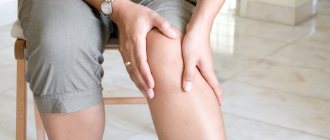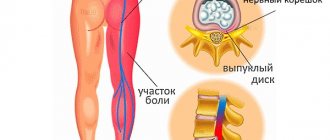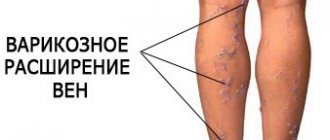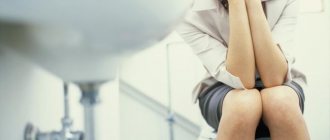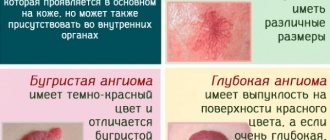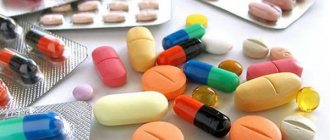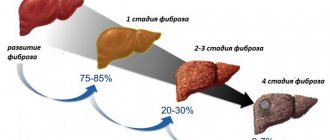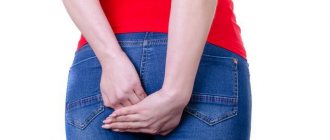Reasons for appearance
A feeling of heaviness in the lower extremities usually appears when the legs swell, pain and a feeling of fullness appear in the lower legs. Such symptoms cannot be ignored, since the development of pathology over time leads to serious negative consequences.
Heaviness in the legs (the reasons for women can be very different) occurs in both young and elderly people. They often feel heaviness in their legs in the evenings and find that their legs are swollen.
The fact that women are more likely than men to be familiar with this pathology is explained by changes in the concentration of progesterone. This hormone makes the vascular walls thin and stretches them.
Its increase in the female body occurs:
- when a woman uses oral contraceptives;
- during pregnancy;
- during corticosteroid therapy.
It is generally accepted that heaviness in the legs and swelling are a consequence of a sedentary lifestyle. But it is not so. There are 2 groups of causes for these symptoms. The first group of causes of heaviness in the legs is explained by factors that have no connection with any pathological processes occurring in the human body.
These include:
- physical inactivity;
- long-term static loads on the body;
- excess weight (in addition to increasing the load on the legs, in obese people the volume of interstitial fluid increases, and contraction of blood vessels is made more difficult due to fat);
- exposure to medications (eg, contraceptives and diuretics);
- hormonal disorders (during puberty, pregnancy, menopause);
- the hot season, when the volume of fluid circulating in the human body changes, which leads to stagnation and dilation of the vessels of the lower extremities.
The second group of reasons is much more dangerous than the first - these are diseases that provoke disruption of blood flow in the legs and can lead to serious complications. A timely visit to a doctor will help determine the true cause of the pathology and begin treatment as early as possible.
Possible causes of heaviness in the legs
The lower limbs are further away from the “pump” that forces plasma into the vessels, the heart, than other parts of the body. This greatly affects the supply of blood to the legs, and therefore oxygen. In order to ensure normal oxygen supply to the legs, the plasma flow must overcome gravity. This becomes much more complicated if there are some pathologies.
In addition, significant pressure is placed on the lower limbs every day. They literally “carry” our body throughout the day.
Heaviness in the legs, which appears after serious physical exertion or a difficult day at work, and disappears without a trace after rest, is a normal phenomenon. But if this feeling is constant, accompanied by pain and swelling, you need to sound the alarm.
As mentioned above, the most important reason for the feeling of heaviness in the leg is poor circulation. Cellular structures lack oxygen, which is simply necessary for their normal functioning. They begin to signal a problem with pain.
But what causes poor circulation? What factors can affect the patency of blood vessels and the supply of oxygen to organs and parts of the body? The causes of heaviness in the legs are different - caused by specific diseases or other factors.
Static loads or adynamia
Static loads and adynamia are completely opposite concepts, but they negatively affect the condition of blood vessels to the same extent.
Static loads are fairly strong, but not rhythmic contractions of muscle fibers. The muscles are under tension for a long time. This seriously impairs blood circulation and leads to venous congestion.
Those most susceptible to this type of stress are those who spend most of the day standing or regularly engage in vigorous physical activity. These categories of people include doctors, professional athletes, hairdressers, sellers, loaders, etc.
Adynamia is a critical lack of physical activity. People who do not exercise at all, lead a passive lifestyle, or have a sedentary job have problems with their veins.
The ideal option for maintaining vein tone is regular rhythmic contractions of muscle fibers. They are provided with sports activities that correspond to the level of physical fitness, state of health, age of the person, and active lifestyle.
Change of seasons
Weather can greatly affect human health. For some, the change of seasons causes headaches, a sharp increase or increase in blood pressure, and dizziness. Weather changes also affect metabolic processes in the body.
In the heat, metabolic processes in the body slow down significantly. Stagnation may form, including in blood vessels. This is accompanied by serious symptoms - swelling, a feeling of heaviness, pain.
Joint pathologies
Congenital defects in the structure of joints or injuries to them can lead to other serious disorders. People suffering from such pathologies complain of “twisting” of their limbs. These sensations may intensify when weather conditions change and the patient’s condition worsens.
Knee bursitis
This disease is an inflammatory process that affects the periarticular bursae of the knee. It is accompanied by severe pain, swelling, discoloration of tissues, and a local increase in temperature. If not treated promptly, knee bursitis can spread downward, affecting a large surface of the limb.
This pathology differs from arthritis in the low severity of pain and less impairment of motor functions.
Osteoarthritis
Osteoarthritis is an inflammatory process that affects articular cartilage. Like many other joint pathologies, it is accompanied by:
- Severe pain.
- Changes in skin color.
- Local increase in temperature.
- Morning stiffness.
- Limitation of motor functions.
- Heaviness and swelling in the legs.
With this disease, the joints are very crunchy. They can change their shape. With the development of osteoarthritis, the inflammatory process can spread to the vessels.
Rheumatoid arthritis
Rheumatoid arthritis is an inflammation of the joints themselves. It is distinguished by acute symptoms:
- Local increase in temperature, fever.
- Edema, swelling of tissues.
- Spontaneous pain that intensifies at the end of the working day, during physical activity.
- Changes in joint shape and motor functions.
- The appearance of vasculitis.
- Heaviness in the legs, etc.
Gout
Gout is a disease characterized by excessive accumulation of uric acid in the plasma. Acute forms of the disease are accompanied by the appearance of tophi - neoplasms in the connective tissue.
In the early stages of development, gout manifests itself as severe discomfort in the big toe, which intensifies during physical activity and when pressed. Next, the process extends to the joints. This is manifested by symptoms familiar to many pathologies of this nature - fever, pain, swelling, limited range of motion.
Spine pathologies
The spine is the “framework” of the body. Violations of its structure lead to pathologies of other organs and systems. The most common spinal ailment that leads to poor circulation is sciatica. It is accompanied by the occurrence of an inflammatory process in the area of the sciatic nerve.
As a rule, sciatica does not bother the patient with discomfort in the spine. Serious discomfort manifests itself in the area of the lower extremities. Symptoms of sciatica include:
- Loss of sensation in the lower extremities, fever, numbness.
- Pain in the buttocks that gets worse when sitting, sneezing or coughing.
- Heaviness and feeling of fatigue in the lower extremities.
- Decreased performance activity.
Obesity
Increased body weight, which is very different from the norm, is a serious illness that must be fought not for the sake of a beautiful body, but for the sake of your own health. Obesity also leads to poor circulation.
Firstly, the pressure exerted on the lower limbs increases significantly. The legs support a lot of weight, to which they are not physiologically adapted. Increased pressure leads to an increase in the volume of circulating fluid (interstitial, plasma).
Secondly, a thick layer of fat puts a lot of pressure on the blood vessels. The outflow of blood worsens, their tone decreases.
Endocrine diseases
Endocrine diseases are accompanied by disruption of the production of vital hormones. Changes in hormonal levels, in turn, lead to pathologies of some organs and their systems.
Atherosclerosis of the arteries
Atherosclerosis of the arteries is a disease characterized by the formation of cholesterol plaques in the thickness of the veins. This leads to a narrowing of the lumen of the arteries and poor circulation.
There are two types of cholesterol - “bad” and “good”. “Bad” cholesterol includes low-density lipoproteins, and “good” cholesterol includes high-density lipoproteins. High-density lipoproteins are simply necessary for the body for the normal functioning of basic life processes. Such substances are found in meat, fish, some vegetables and fruits.
Low-density lipoproteins lead to the formation of cholesterol plaques. You can only get rid of them surgically; medications will only stop their formation.
To reduce the percentage of these components in the blood, it is necessary to normalize nutrition. Eliminate fatty, salty and spicy foods, diversify your diet with plant-based foods.
Atherosclerosis of the arteries is characterized by the following symptoms:
- Contracting pains.
- Heaviness in the lower extremities, swelling.
- Local decrease in temperature in the area of the feet, which does not depend on air temperature, etc.
Heart diseases
Blood circulation is provided by a “pump” - the heart. Of course, diseases of this organ of the system will seriously affect the functioning of blood vessels.
Cardiomyopathy
Cardiomyopathy is not a separate disease, but a whole classification of heart pathologies. They are somewhat different from standard diseases, since they are caused not by damage to the coronary vessels, but by dysfunction of the myocardium itself (heart muscle).
Cardiomyopathy, as a rule, is not accompanied by an increase in blood pressure. It is characterized by the following symptoms:
- Shortness of breath.
- Decreased performance.
- Rapid fatigue of the patient.
- Feeling of heaviness and pain in the legs, swelling.
- Unpleasant sensations in the chest area.
- Frequent fainting, etc.
If not treated promptly, symptoms of heart failure may appear. Some forms of cardiomyopathy are life-threatening for the patient.
Pericarditis
Pericarditis is a disease accompanied by an inflammatory process in the myocardial lining. The following symptoms are characteristic of this disease:
- Cardiopalmus.
- Shortness of breath not only after prolonged physical exertion, but also after walking or climbing stairs.
- Rapid weight loss.
- Frequent fainting.
- Severe pain in the chest area.
- Dry cough and bleeding when coughing.
- General weakness of the body, decreased immunity.
- Feeling bloated.
- Swelling in the lower extremities, etc.
Heart failure
Chronic heart failure is usually a consequence of lack of professional intervention for other diseases of the cardiovascular system. It is characterized by violations of the basic functions of the myocardium.
The symptoms of heart failure differ little from the symptoms of some other diseases of the cardiovascular system:
- Weakness, decreased performance, low fatigue.
- Swelling due to blood stagnation.
- Deformation of the nail plates.
- Change in skin color.
- Excessive hair loss.
- Shortness of breath and fainting.
- Dry cough, etc.
Vascular diseases
Vascular diseases are the direct cause of heaviness in the legs. This symptom is accompanied by:
- Thrombophlebitis.
- Phlebeurysm.
- Atherosclerosis, etc.
Phlebeurysm
Varicose veins are one of the most common diseases affecting blood vessels. It can occur not only as a result of circulatory disorders, but also during pregnancy, due to hereditary predisposition, etc.
The disease develops over quite a long time and at first may not manifest itself at all. The first and main symptoms of varicose veins are:
- Venous stars on the legs, arms, face and other parts of the body.
- A strong feeling of heaviness in the legs, which increases at the end of the working day.
- Swelling not only in the feet, but throughout the entire surface of the leg.
- Burning and pain.
- Frequent seizures, etc.
With the help of conservative treatment methods, the development of the disease can be significantly slowed down or even eliminated. But there are also factors that only contribute to the further progression of varicose veins:
- Excessive loads or, conversely, a passive lifestyle.
- Constant static loads.
- Obesity.
- Use of certain medications containing hormones, etc.
There are many types of treatment for varicose veins:
- Taking medications.
- Surgical intervention.
- Wearing special compression garments, etc.
Kidney diseases
Kidneys are one of the organs responsible for fluid exchange in the body. Pathologies of this organ lead to stagnation of lymph and disruption of the blood supply to individual systems of the body. Such ailments include:
- Various forms of renal failure.
- Nephrotic syndrome, etc.
Lymphostasis
Lymphostasis in simple terms is fluid retention in the legs. This disease can be congenital or acquired. Causes of impaired fluid excretion include trauma, burns, inflammation, or complications after surgery.
Lymphostasis is characterized by the following symptoms:
- Swelling of the legs.
- Heaviness and pain in the legs.
- Infectious and inflammatory processes.
- The occurrence of trophic ulcers, etc.
Flat feet
Flat feet is a disorder of the structure of the foot. It is accompanied by serious pain, fatigue and heaviness in the legs. Flat feet can be congenital or acquired. In the absence of conservative treatment or surgical intervention, the disease can lead to heel spurs, spinal pathologies, etc.
Signs of flat feet are the following:
- Shoes wear out quickly and stretch.
- The size of the foot increases.
- There is pain, a feeling of heaviness after a long walk or standing.
- At the end of a working day, swelling and cramps occur in the lower extremities.
- Girls cannot wear shoes even with low heels due to severe discomfort.
Diabetes
Heaviness in the legs is one of the very first symptoms of diabetes. It refers to diseases of the endocrine system and can cause pathologies in other organs and systems of the body.
In addition to heaviness and pain in the legs, diabetes mellitus is manifested by excessive dry skin. In the absence of timely intervention by specialists, the affected limb is amputated.
Pregnancy
During pregnancy, hormonal levels change greatly. In addition, pressure on the lower limbs increases. The pelvic vessels are compressed. Plasma volume increases. All these changes lead to vascular pathologies.
During pregnancy, many girls suffer from varicose veins. This disease is accompanied by heaviness in the legs, the appearance of spider veins, and poor circulation.
Possible diseases
Heaviness in the legs (the reasons for women and men include a serious illness) can be caused by diseases that can aggravate the condition of the blood vessels in the lower extremities:
- joint diseases;
- problems with the spine;
- cardiovascular diseases;
- kidney disease;
- pathology of the blood vessels of the legs.
Joint diseases are arthrosis, arthritis, flat feet. Arthrosis occurs due to degenerative-dystrophic phenomena in the joints. In this case, the person complains of severe and rapid fatigue of the legs, aches and a feeling of stiffness, although pain does not always accompany these symptoms.
Inflammation of the joints indicates the development of arthritis. The causes of this condition may be infections, autoallergic reactions, and others.
Flat feet is a pathological condition of the foot in which its arch is lowered. At the initial stage, a person feels heaviness, notices that his legs quickly begin to get tired, swell and ache. These symptoms increase with the development of the pathology and lead to deformation of the foot to such a state in which a person cannot wear ordinary shoes.
A pathology of the spinal column that causes pain in the legs is lumbosacral osteochondrosis. It is characterized by displacement of intervertebral discs. Initially, a person feels pain in the lower back, and periodically the muscles in his calves contract involuntarily.
When the disease enters the acute stage, the patient may experience loss of sensation in the legs, decreased muscle contractions, and vegetative-trophic disorders.
Swelling and heaviness in the legs can be manifestations of diseases of the heart muscle. Whatever the cause of edema, you need to take it seriously and consult a specialist at the first manifestations.
Diseases of the genitourinary system, such as chronic renal failure, as well as glomerulonephritis and others, at the beginning of their development also cause swelling of the legs. This may cause spots to appear on the skin. Patients complain of itching and thirst.
Those at risk of experiencing heaviness in the legs are people with varicose veins and venous insufficiency. The first symptoms are heaviness in the legs, which makes itself felt in the afternoon.
Over time, the situation worsens: involuntary muscle contractions and swelling of the legs appear. , inflammation of the walls of superficial veins and blockage of arteries may appear
It is important to prevent irreversible consequences such as the appearance of ulcers and gangrene. In this case, amputation cannot be avoided.
Traditional treatment for heavy legs
Today, quite a few folk remedies are known, thanks to which you can get rid of the unpleasant feeling of heaviness in your legs in a short period of time. Let's talk about the most effective folk methods that, according to women, helped them solve this problem.
Treatment of heavy legs with folk remedies:
Latest information: Causes of veins appearing on the penis
Prevention of vein diseases
Heaviness in the legs certainly causes a bad mood and creates discomfort. Doctors say that these sensations are unnatural and do not just happen. They indicate that something is not entirely right in the body, and it is precisely such symptoms that serve as a signal of dysfunction of the veins.
Fortunately, if you notice the problem in time, it can be solved. The process of varicose veins can be prevented by giving up bad habits (smoking, alcohol, eating fatty and fried foods) and adhering to the following principles:
1. Avoid standing still for long periods of time. Be sure to make small movements every half hour - bending and straightening your knees, turning your head and shoulders.
2. If you are in a sitting position while working, then under no circumstances cross your legs - this is one of the most dangerous positions that provokes vein disease.
3. Try to walk more; prefer going up and down the stairs to elevators.
4. Avoid foods containing toxic substances. Drink plenty of pure water (but not before bed), it cleanses the body of toxic substances and excess salts.
5. Limit your salt intake.
6. You should not wear tight tights, socks, stockings, or tight skinny jeans.
7. At the pharmacy you can purchase special preventive tights that prevent the development of varicose veins.
8. You should not wear shoes with heels greater than 5 cm. This is how heaviness and pain in the legs most often arise, the causes of which lie in ordinary stiletto heels. The ideal heel height, according to doctors, is 2-5 cm.
9. Make it a habit to perform one effective exercise - lie on the floor, laying a soft blanket, let your legs be higher than your body position (with support on a wall, closet), you need to stay in this position for 1-2 minutes. This exercise will help normalize blood circulation.
10. Avoid hot baths, hot waxing, solariums, and prolonged exposure to the sun. High temperatures are the main enemy of our blood circulation.
11. Take a contrast shower in the morning and evening. It helps strengthen the walls of blood vessels and also serves as a prevention of inflammatory processes. Low temperatures will relieve swelling, swelling, discomfort, a feeling of fatigue and a feeling of heaviness.
12. Before going to bed, massage your feet - massaging your legs from bottom to top.
13. Use warm foot baths adding salt, tea or oils (salt improves blood circulation, and lavender essential oils or green tea have a refreshing effect).
14. Give preference to products containing a high percentage of fiber, which enhances intestinal motility, thereby producing a cleansing effect on the body.
15. Avoid fatty, fried, and especially smoked foods.
16. Completely eliminate cigarettes and alcoholic beverages from your life.
17. Take vitamins and substances that promote the elasticity of the walls of blood vessels and veins (vitamin C, citrines). Ask at the pharmacy for chestnut extract, linden extract, tincture of birch leaves - these are effective remedies that can improve the condition of our veins and blood vessels.
Try to change your lifestyle, this will not only normalize blood circulation, eliminate heaviness in your calves, but also improve your overall well-being, mood, and also prolong your youth. The feeling of heaviness in your legs will remain only a bad memory
Remember, prevention of varicose veins is an extremely important phenomenon that will help avoid one of the most dangerous diseases that pose a threat to our lives.
I advise you to read: how to cure varicose veins
Diagnostics
Since heaviness in the legs is considered nonspecific (common to several diseases), it is necessary to find out the reason for its appearance in women or men. If heaviness in the lower extremities is not accompanied by other symptoms, then the patient will be prescribed laboratory tests that will give a complete picture of the condition of the whole organism.
Diagnostics consists of several stages:
- collecting anamnesis (examination and questioning of the patient about his condition);
- blood test for biochemistry and detailed (helps determine the risk of blood clots);
- blood test for rheumatic tests (to detect inflammation in connective tissues);
- urine test (general);
- blood sugar test;
- venography (X-ray examination with a contrast agent, which allows diagnosing venous insufficiency);
- computer planktography (a picture using a webcam of the foot to diagnose its pathologies);
- duplex scanning of the vessels of the lower extremities with ultrasound (determines the nature of blood flow in the vessels of the legs);
- electrocardiogram (recording of electrical activity of heart cells);
- Ultrasound of the heart (for diagnosing heart diseases);
- computed tomography of the veins (X-ray scan that determines pathologies of the blood vessels of the legs);
- magnetic resonance therapy (shows the condition of the joints, ligaments, soft tissues of the foot);
- coronary angiography (identification using x-rays of lesions in the coronary arteries of the heart).
All these procedures are performed in diagnostic centers located in all major cities. Prices for services vary.
| Procedure name | price, rub. |
| Consultation and examination | from 1000 |
| General blood analysis | up to 400 |
| Blood test for biochemistry | from 1200 to 3800 |
| General urine analysis | 200 |
| Blood test for rheumatic tests | 800 |
| Blood sugar test | up to 500 |
| Phlebography | from 5000 |
| Computer planktography | from 1000 |
| Duplex scanning | 4600 |
| Electrocardiogram | from 1800 |
| Ultrasound of the heart | 3000 |
| Computed tomography of veins | from 4000 to 6000 |
| MRI | 14900 |
| Coronary angiography | From 15000 to 61000 |
According to experts, the most effective diagnostic methods are Doppler ultrasound and duplex scanning. After completing these studies, the picture of the dynamics of blood flow in the veins of the lower extremities becomes clear, the nature and extent of vascular damage by blood clots, and the operation of venous valves are determined. These methods allow you to make a diagnosis of varicose veins.
Treatment
Treatment of pain and weakness in the legs that occurs with osteochondrosis is aimed directly at treating the disease itself and eliminating the symptoms.
Baths help relieve leg pain
Conservative therapy
For acute pain, bed rest may be prescribed. Removing the load from the spine allows you to get rid of pain in the back and legs and muscle weakness. The patient should lie on a hard surface. It is better to place a small cushion or pillow under your knees to relieve compression of the nerve roots. Bed rest should not be prolonged for a long time: this can cause weakness in the muscles of the back and legs.
Drug therapy
Medicines are used for:
- eliminating pain in the back and legs;
- reduction of inflammation;
- relieving spasms;
- restoration of normal blood circulation in the affected part of the back and legs;
- improving metabolic processes.
Prescribed:
- painkillers;
- muscle relaxants;
- non-steroidal anti-inflammatory drugs;
- steroids;
- chondroprotectors;
- drugs to improve metabolic processes;
- vitamins and minerals;
- intra-articular blockades, injections of synovial fluid - can be prescribed for intense pain and numbness in the legs.
Physiotherapy
Physiotherapeutic methods for treating osteochondrosis help improve blood circulation, eliminate muscle spasm and compression of the nerve root, thereby eliminating pain and weakness. Most often prescribed:
- laser therapy;
- magnetic therapy;
- shock wave therapy;
- acupuncture;
- electrophoresis.
Massage
Massage helps relieve pain
For osteochondrosis, classical and acupressure massage is prescribed to relieve or alleviate pain and eliminate weakness (it affects acupuncture points).
It can be carried out after the inflammation has subsided. Massage helps:
- eliminate muscle spasms;
- restore trophism of muscle tissue;
- improve blood circulation;
- normalize metabolic processes.
Physiotherapy
Exercise therapy is aimed at increasing muscle tone, improving blood circulation, preventing congestion and restoring the mechanics of body movement. The complex must be selected by a specialist.
Manual therapy
This method is particularly effective for pain and weakness in the legs. As a result of a well-conducted session, the main cause of pain is eliminated – compression of the nerve root. The technique also allows you to improve blood flow, eliminate muscle spasms, and restore sensitivity in the lower extremities.
Surgery
It is prescribed for the ineffectiveness of conservative methods, severe pain, loss of sensation in the lower extremities, and disruption of the functioning of internal organs.
Attention!
When to see a doctor
Heaviness in the legs (the reasons for women are difficult to determine independently) can lead to serious consequences. If the symptom appears regularly, accompanied by swelling, pain and other symptoms in the body, you should consult a physician as soon as possible.
A common cause of heaviness in the legs of women is long-term wearing of high-heeled shoes.
After examining and collecting anamnesis, he will make recommendations regarding observation by other specialists, such as:
- cardiologist;
- nephrologist;
- endocrinologist;
- phlebologist;
- rheumatologist.
Particular attention should be paid to the state of the female sphere of the body (hormonal levels, manifestations of menopause, taking contraceptives).
Vascular pathologies - veins and arteries
If you often have a question about how to get rid of heaviness in your legs, then you cannot rule out any of the problems of the blood vessels:
- Atherosclerosis is a disease affecting the arteries in the legs. Cholesterol plaques appear on the vascular walls, causing a person to suffer from severe pain. The main discomfort is concentrated in the calf area; the patient’s feet feel cold, even when it’s warm outside.
- Endatheritis is an inflammatory process in the arteries of blood vessels, leading to damage to the lower extremities. The first manifestation of the disease is that a person begins to limp. Because of the latter, numbness in different parts of the legs often occurs, pain appears, the feet often freeze, and the legs experience cramps.
- Damage to varicose veins - Constant heaviness in the legs, as well as unreasonable fatigue in the legs, can make a person’s life unbearable. Especially if the cause of pain in the legs is varicose veins. The pathological process develops over a fairly long period – up to 10 years. In the first stages, the patient does not feel significant discomfort. In this case, therapeutic procedures to relieve leg fatigue should be carried out at the first suspicion of varicose veins.
- Thrombophlebitis – few people manage not to feel tired legs after work. However, such a sign may indicate that you are developing a dangerous pathology. If venous blood stagnates in the vessels, a blood clot will soon form. Many people try to cope with throbbing painful sensations with the help of ointments for tired legs. If you do not start using more serious medications and methods in the near future, the consequences can be disastrous.
As a rule, advanced thrombophlebitis ends in the death of the patient.
Prevention
To avoid problems with your legs in old age, you need to constantly monitor your health.
Heaviness in the legs (causes for women and men can appear at a young age) often occurs in girls who, for the sake of beauty, are ready to wear high-heeled shoes. Therefore, it would be right to change your shoes to more comfortable and stable ones.
If a person is diagnosed with flat feet, you need to purchase special insoles with arch supports and regularly do leg exercises.
Those who spend a lot of time in a static position (at the computer, drawings, etc.) need to periodically get up and do a warm-up - simple exercises for different muscle groups. It is especially important to stretch your legs: squat, walk up the stairs, roll from heel to toe, dance.
Everyone benefits from walking, regardless of age or lifestyle.
If possible, you should exercise as much as possible. This could be cycling, Nordic walking, swimming, slow running.
Since varicose veins are hereditary, you need to take care of the condition of the veins before the first symptoms of a dangerous pathology appear - do preventive exercises. And if the symptoms are already making themselves felt, you need to buy compression socks or tights.
Obesity is a factor that causes heaviness in the legs. You can stop the development of the pathological process by adjusting your diet and physical activity. Losing weight will have a beneficial effect on the condition of the lower extremities and the whole body.
After a hard day, a good way to prevent and treat feet are foot douses with cool water and baths:
- contrasting;
- with the addition of sea salt;
- with herbal decoctions.
Massage relieves fatigue and heaviness in the legs.
If any pathology is diagnosed, you should not visit the sauna, bathhouse or solarium, or stay in direct sunlight for a long time.
Manifestation of a feeling of heaviness in the body
Very often, people believe that a feeling of heaviness in the body or heaviness in the limbs is a consequence of physical fatigue, hard work, or a consequence of some kind of physical ailment, which can often accompany such sensations.
For example, patients who feel heaviness in the body or limbs often turn to a gastroenterologist with complaints of indigestion or pain in the stomach, where examination often reveals various pathologies in the form of gastritis, gastric erosions, and biliary dyskinesia. There may be such unpleasant manifestations as intestinal flatulence, diarrhea, constipation, seething or rumbling in the abdomen. It is not uncommon for heaviness in the limbs to be accompanied by various pain sensations in the heart or upper abdomen.
When patients complain of heaviness in the body or limbs to a cardiologist, in most cases various “pathologies” are found in the form of extrasystole, ventricular hypertrophy, and often even arrhythmias or insufficiency of the heart valve system, blockade of the Hiss legs, various types of changes in electrocardiogram, tachycardia, hypertension and many other changes.
When patients who feel heaviness in the body or limbs consult a neurologist, osteochondrosis, insufficiency of venous outflow or disorders of the arteries in the cervical vessels are most often recorded. During MRI examinations of the brain, aneurysms, cysts, expansion of various basins, etc. are found. When examining the EEG, there are also quite a few changes in the form of changes in various activities, waves, even convulsive readiness and what the EEG in principle cannot show (spikes, structural changes, etc.). At the same time, complaints about sensations of heaviness in the limbs receive their own specific explanation and fade into the background.
Possible treatment options for heaviness in the body
People who complain of a feeling of heaviness in the body or limbs most often come to the therapist with additional complaints such as: constant body temperature at 37.0 - 37.6, headaches, sleep disturbances, coughing, frequent belching, malaise , frequent colds. Moreover, and here there are often explanations for the sensations of heaviness in the limbs or in the body, for example, in the likely presence of small deviations in hemoglobin, leukocytes or red blood cells, small changes in the hormonal sphere can also be detected, most often these are indicators of the thyroid gland.
As a rule, the treatment prescribed by these doctors does not help much, and more often than not it has no effect, or may get worse. The feeling of weakness in the body or limbs does not go away, but other unpleasant or painful sensations in the body may be added and registered by other doctors. Doctors are prescribing more and more new treatments; there are more and more different pathologies that require “urgent treatment”, which, like the previous ones, does not give the desired effect. This pathology, which is detected by a cardiologist, gastroenterologist or neurologist and therapist, in combination with feelings of heaviness in the body or heaviness in the limbs, most often has a direct relationship to a disorder of higher nervous activity and indicates the presence of some kind of mental disorder.
A person who feels heaviness in the body or limbs most often ends up in a “vicious circle” and goes from one doctor to another until he gets to a good, conscientious doctor who will refer him to a psychiatrist, psychotherapist (psychotherapist) or himself will not accidentally come to the attention of a psychotherapist. But, in most cases, people do not want to admit that they have mental disorders and believe that the doctor who referred him to a psychotherapist is illiterate and just wants to get rid of him, because he does not know how to treat him. Such people often insist on continuing complex examinations and treatment, regardless of reasonable advice, and often end up on the operating table without any objective evidence for this.
Treatment methods
One of the common causes of heaviness in the legs is long-term static loads and a sedentary lifestyle. Doctors, teachers, office workers, hairdressers and others suffer from this.
Since it is impossible for such categories of people to eliminate provoking factors, they should pay attention to exercises to restore normal blood circulation in the legs, massage, and proper rest (regular walks, cycling, swimming). While sleeping, it is useful to place a cushion from a blanket under your feet.
If the cause of your foot problems is flat feet, then you need to purchase special insoles and regularly do foot exercises (walking around the house on the inside or outside of the foot, lifting small objects from the floor with your toes, etc.).
Medications
For varicose veins, the doctor prescribes complex treatment, which involves:
- correction of insufficient valve function;
- elimination of external symptoms of the disease;
- prevention of its further development.
Among the medications, venotonics are needed, which improve the condition of blood vessels, activate the flow of blood and lymph, and eliminate heaviness in the legs.
These include:
- Detralex (take 1 tablet morning and evening with meals). Price for 30 pcs. (500 ml) – 770 rub. The course of treatment is several months. It has a noticeable angioprotective and venotonic effect.
- Troxevasin (gel or capsules) – for external use. The drug protects cell membranes from oxidation, reduces swelling, relieves pain, and improves microcirculation. Troxevasin is applied to the affected areas 2 times a day. The course is until symptoms are completely eliminated. The price of the gel is from 240 to 320 rubles, capsules – 500 – 650 rubles.
- Aescusan (drops) – the drug is an extract of horse chestnut seeds. Eliminates increased vascular permeability, relieves inflammation, removes swelling, cramps, and heaviness. Take 12–15 drops 3 times a day. Course – from 2 weeks to 2 – 3 months. Price – from 170 to 205 rubles.
In addition to venotonics, patients are prescribed angioprotectors:
- Angionorm - tablets that relieve inflammation and have an angioprotective effect, improve microcirculation and the general condition of the body. The tablets should be taken 3 times a day after meals for 3 weeks. Price for 100 pcs. – 547 rub.
- Troxevasin - capsules, which are taken in 1 piece. orally 3 times a day with meals. The course of admission is up to 1 month. The price of the package is about 300 rubles.
- Troxevasin (gel) strengthens the walls of blood vessels, relieves inflammation, swelling, prevents capillary fragility, and makes the walls of blood vessels dense. It is applied to problem areas 2 times a day. The course is several months.
If the cause of heaviness in the legs is diseases of the kidneys, heart or spine, then specialists prescribe therapy aimed at normalizing the functions of these organs.
Traditional methods
If you have heaviness in your legs, you can also use folk remedies, but it should be borne in mind that this is effective only in the absence of serious diseases. And if varicose veins have already developed at a stage when the veins are greatly dilated, you need to rely only on official medicine.
Folk remedies are good for preventing diseases (for example, varicose veins) or relieving fatigue.
A good remedy is nutmeg. The following tincture is prepared from it: a powder is made from the nut kernels, and then infused with alcohol (300 g of 90% alcohol is taken per 50 g of powder). After a week of storage in a dark place, the product is ready for use. The tincture is taken 20 drops 3 times a day.
The next folk remedy for varicose veins is chestnut tincture. The fruits are poured with alcohol (it better extracts escutin from them, which relieves inflammation and swelling) and put away in a dark place for 2 weeks. Directions for use: 40 drops orally 3 times a day.
Rubbing your feet with a piece of frozen infusion with mint, as well as taking a bath with infusion of nettle and plantain will help relieve heaviness and pain. A decoction of coltsfoot and salt baths have a good effect on the blood vessels of the legs and feet.
Contrast baths and compresses of essential oils of lavender, eucalyptus, and lemon added to medical gel are useful for the feet.
Other methods
If a person suffers from severe and constant pain in the legs, it may be varicose veins. There are several ways to eliminate it.
Laser obliteration is a method that allows thermal influence on the inner surface of the venous arteries in order to “seal” the vessel. The procedure is done in a hospital and takes from half an hour to an hour.
The patient can independently leave the hospital after 30 minutes. The advantages of obliteration are a minimum of surgical intervention, the risk of complications, pain after the procedure and the speed of recovery.
The next method of therapy is miniphlebectomy. It is a method of removing dilated veins through punctures. As a result, the patient is cured of varicose veins, which gives a good aesthetic effect.
Advantages of the operation:
- scars do not remain on the body;
- there is no need to stay in hospital for a long time;
- fast healing;
- good tolerance;
- no age restrictions.
How to relieve heaviness in your legs?
How to get rid of the feeling of heaviness in your legs? Unfortunately, there is no exact answer to this question. Heaviness in the legs is just a symptom, but not a separate disease. That is why, in order to get rid of this unpleasant feeling, it is necessary to eliminate the main cause of its occurrence.
There are different methods for treating heavy legs:
- Taking medications. The doctor prescribes a course of medications that will help get rid of the cause of the discomfort. It is strongly not recommended to prescribe a course of treatment for yourself.
- Surgical intervention. It is necessary if there are serious joint pathologies, extreme venous obstruction, etc.
- Use of medicinal ointments and creams. They alleviate the condition somewhat, eliminate pain and discomfort.
The exact method of treatment should be determined by a specialist after a complete diagnosis and diagnosis. You should not self-medicate, as it can only worsen the patient’s condition.
Drug treatment
Let's take a closer look at drug treatment, since it is one of the most common in getting rid of a wide variety of ailments.
When there is heaviness in the legs, first of all, those drugs are prescribed that help increase vascular tone and normalize blood circulation. One of the most common drugs of this type is “Troxevasin” in tablets.
To reduce pain and discomfort in the lower extremities, painkillers are prescribed. Anti-inflammatory medications help eliminate inflammatory processes.
The doctor approves the exact list of medications based on the diagnosis.
Traditional methods
An alternative treatment method is the use of folk remedies. It is not welcomed by specialists because it is unscientific. The benefits of many traditional medicines have not been established. Using this method may not only not bring results, but also worsen the patient’s condition.
The main folk methods against heavy legs that can be used at home include:
- Infusions of chestnuts and pine nuts.
- Applications with blue clay.
- Banana pulp compresses.
- Decoctions of medicinal herbs.
- Baths with sea salt and essential oils, etc.
Possible complications
A symptom such as heaviness in the legs may signal the onset of a serious illness. And if it is not treated in time, diseases may develop that will lead to serious consequences, even death. Such dangerous diseases are renal failure, heart pathologies and thrombophlebitis.
Heaviness in the legs can cause problems during pregnancy and during menopause in women. To protect yourself from further problems, you should visit a doctor to determine the cause and begin therapy.
Heaviness of legs in women
According to the latest study by the Interactive Marketing Research Institute of the European Union, it turns out that more than 72% of women aged 25-55 years experience difficulties associated with poor circulation in the extremities. The main percentage is made up of older women. And although most women claim that they feel heavy legs at least once a week, only 1/5 of those surveyed admitted that they deal with this problem by taking medications or doing physical exercise.
But difficulties associated with impaired circulatory function can lead to varicose veins, which cause not only aesthetic discomfort, but also provoke the formation of blood clots, which is a dangerous threat to life.

